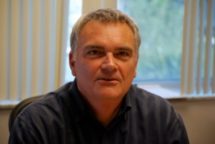Lecture
Invited speaker: Edward W. Large (University of Connecticut)
Title: How baby gets the groove: Modeling rhythm learning, perceptual narrowing, and enculturation
Co-presented with BRAMS.
Ontogeny is a complex, emergent process that arises from interactions between the developing organism and the structures present in the rearing environment. In the field of infant development, one of the most well known consequences of organism-environment interactions is the adaption and re-organization of perception-action systems to structural regularities in the environment, a phenomenon called “perceptual narrowing” or “perceptual fine tuning.” Previous work suggests that infants’ perception of musical rhythms is gradually fine-tuned to culture-specific musical structures over the first post-natal year. To date, however, little is known about the neurobiological principles that underlie this process. In the current study, we modeled infants’ perceptual narrowing to culture-specific musical rhythms using oscillatory neural networks with Hebbian synaptic plasticity. We demonstrate that, during a period of unsupervised learning, oscillatory networks adapt to the rhythmic structure of Western and Balkan musical rhythms through the self-organization of network connections. We show that these learned connections affect the ability of the network to discriminate between native and non-native rhythms, a pattern of findings that mirrors the behavioral data on infants¹ perceptual narrowing to musical rhythms. We develop an overall framework for modeling rhythm learning and development, and discuss how this may account for the process of enculturation to the rhythms of one’s musical environment.
 Dr. Edward W. Large directs the Music Dynamics Laboratory at University of Connecticut, where he is a Professor of Psychological Sciences and Professor of Physics. He is Associate Editor at Frontiers in Auditory Cognitive Neuroscience and Music Perception and he recently completed a term as President of the Society for Music Perception and Cognition. Dr. Large received his Ph.D. from The Ohio State University in 1994, completing a dissertation titled “Dynamic Representation of Music Structure,” and he completed postdoctoral work at University of
Dr. Edward W. Large directs the Music Dynamics Laboratory at University of Connecticut, where he is a Professor of Psychological Sciences and Professor of Physics. He is Associate Editor at Frontiers in Auditory Cognitive Neuroscience and Music Perception and he recently completed a term as President of the Society for Music Perception and Cognition. Dr. Large received his Ph.D. from The Ohio State University in 1994, completing a dissertation titled “Dynamic Representation of Music Structure,” and he completed postdoctoral work at University ofWhere: Université de Montréal, Pavilion Marie-Victorin, room A-135

